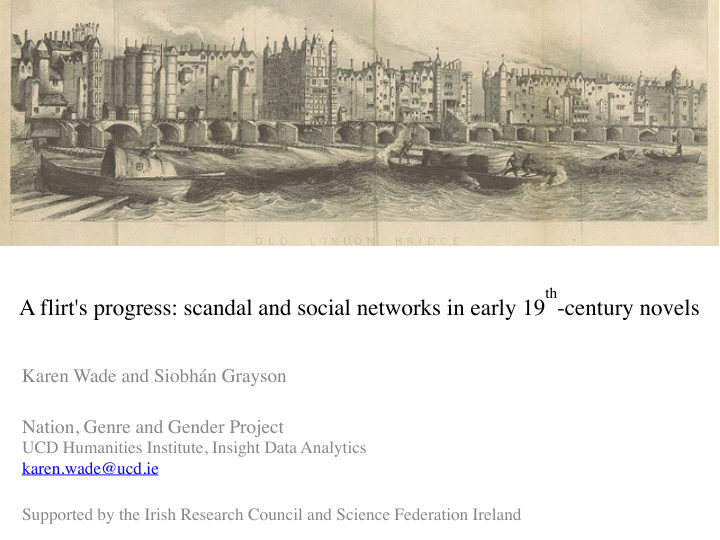



th -century novels A flirt's progress: scandal and social networks in early 19 Karen Wade and Siobhán Grayson Nation, Genre and Gender Project UCD Humanities Institute, Insight Data Analytics karen.wade@ucd.ie Supported by the Irish Research Council and Science Federation Ireland
Our importance, our respectability in the world must be affected by the wild volatility, the assurance and disdain of all restraint which mark Lydia's character ... If you, my dear father, will not take the trouble of checking her exuberant spirits, and of teaching her that her present pursuits are not to be the business of her life, she will soon be beyond the reach of amendment. Her character will be fixed, and she will, at sixteen, be the most determined flirt that ever made herself or her family ridiculous…
The Nation, Genre and Gender Project: a summary of our data Corpus statistics (June 2016): - 46 novels by 29 different authors, published between 1800 and 1922 - 1709 total chapters - 9,630 total unique characters - 5,422,266 total words
Radical inclusivity In the process of data gathering, our annotators identify every possible character for inclusion in the social networks - from This can result in enormous communities – Pride and Prejudice has a relatively modest cast, at 117 characters, while Middlemarch’s population is 333, and Vanity Fair contains over 600 characters.
How connections become maps
What the networks look like: examples from Phineas Finn The complete novel Chapter 34
Allow me to introduce my good friend, Mr. Wickham… https://www.youtube.com/watch?v=taGgnxSqFZk 9.55-11.56
A walk into Meryton: taking a closer look at Chapter 15
Modularity: characters’ tendency to group together
Centrality Degree centrality – top characters Betweenness centrality – top characters elizabeth bennet elizabeth bennet jane bennet mrs. bennet mr. darcy jane bennet mrs. bennet mr. bingley mr. bingley mr. darcy mr. wickham mr. wickham lydia bennet charlotte lucas mr. collins lady catherine de bourgh charlotte lucas lydia bennet mr. bennet mr. collins
Centrality and the single girl Progress through the novel, chapter by chapter
Social class distribution throughout the novel Upper aristocrats, heiresses, very wealthy members of the gentry = 23 of 117 chars (19.7%) Middle the gentry and professionals = 51 of 117 chars (43.6%) Working tradespeople, servants and service providers = 43 of 117 chars (36.7%)
Knowable communities: four-and-twenty families Look back, for a moment, at the knowable community of Jane Austen. It is outstandingly face-to-face ; its crises, physically and spiritually, are in just those terms: a look, a gesture, a stare, a confrontation; and behind all these, all the time, the novelist is watching, observing, physically recording and reflecting. That is the whole stance - the grammar of her morality. Yet while it is a community wholly known, within the essential terms of the novel, it is as an active community very precisely selective. Neighbours in Jane Austen are not the people actually living nearby; they are the people living a little less nearby who, in social recognition, can be visited. What she sees across the land is a this tightly drawn mesh most actual people are simply not seen. network of propertied houses and families, and through the holes of To be face-to-face in this world is already to belong to a class. No other community, in physical presence of in social reality, is by any means knowable. And it is not only most of the people who have disappeared ... It is also most of the country, which becomes real only country is weather or a place for a walk. (241, emphasis mine) as it relates to the houses which are the real nodes; for the rest of the Williams, Raymond, Culture and Society, 1780-1950 (Columbia University Press, 1983)
Eight million out of nine million: the depiction of the poor in Pride and Prejudice Pride and Prejudice also includes a large number of characters who are servants, many identified by name. As most of them have no dialogue and do nothing to forward the plot, their presence in the novel at all may seem curious, but the depiction of the working class would have been a clear message to Austen's original readers, as the servants in Pride and Prejudice refute the assumptions of prominent radical Whig politicians Edmund Burke, Frederic Eden, Jeremy Bentham, and Patrick Colquhoun, who depicted the lower class as ignorant, dishonest, and wasteful. (50) - Craig and Eckersley, Jane Austen and the State of the Nation (Springer, 2015)
A private had been flogged: Lydia talks The sudden intrusion of such a disagreeable incident comes as a shock, as was intended. Jane Austen has flouted convention. As she did with the brief airing of slavery in Emma, she manages to show us that she disapproves both of flogging and of the two younger girls for bringing up the subject, and worse still callously sandwiching it between two items of idle gossip. • Breihan, John, and Clive Caplan, ‘Jane Austen and the Militia’, Persuasions: Journal of the Jane Austen Society of North America, 14 (1992), 16–25
“Such low connections”: Elizabeth and Lydia’s egonetworks Elizabeth Lydia
Parallel progress Elizabeth Lydia
Recommend
More recommend